Your computer can produce a vast array of characters and symbols (e.g. Unicode UTF-8) but the standard laptop keyboard has only 48 keys. They can do little more than cover 48×2=96 different characters. So, if you want to name non-anglo people, places and phenomena correctly you'll need to distinguish between Åström and Astrom, and between lecon (vulgar/grossier) and leçon (=lesson). You have to know how to produce letters like Å and Ç. If you write about music you'll also need to generate the shape of sharps, flats, naturals and short snippets of notated rhythm at your computer keyboard. You might also want to spell Dvořák properly, or explain the Greek origins of ‘polyphony’ (πολύ and φωνή) or quote something in Russian or Chinese.
There are three main ways of using your computer keyboard to produce non-anglo symbols and characters:
PCs and Macs both have ways of generating Á É Í Ó Ú À È Ì Ò Ù Â Ê Î Ô Û Ä Ë Ï Ö Ü Ã Ñ Õ Å Ø Ç (with lower-case, too) but neither Windows nor Mac make it easy for anyone with a Western European or North American computer to generate letters like Ă Č Ğ İ Ł Ň Ő Ř Ś Š Ț Ů Ű Ŵ Ŷ Ž Ż from the same keyboard layout, nor do they offer easy routines for writing in Russian, Bulgarian, Mongolian or Greek. Three keyboard layouts presented below address those issues.
Your keyboard can be mapped so that existing keys can produce any character with a code number in the UNICODE set (UTF-8). The AltGr key can be used to access those values (ç, š, ö, â, ñ, etc.), as can dead-key combinations (e.g.^ [circumflex] directly followed by e to produce ê). Dead keys are the safest way of producing diacritic letters and are at the base of [1] Tagg's multilingual keyboard; [2] the Greek Polytonic keyboard covering both Modern and Ancient Greek characters; [3] the Russian keyboard with keys set so that typing "Vladimir Putin" produces Владимир Путин.
2. Fonts
Many fonts provide tables interpreting codes from the keyboard in ways that do not merely provide aesthetic variants of the same letter (like this or this or this). For example, typing lower-case L (l) in the XPTmusic1 font produces a crotchet or quarter-note, while upper-case L produces a crotchet rest, $ produces ♭ (flat sign) etc. In short, fonts let you type various kinds of non-verbal symbols.
Several problems caused by the anglocentrism of traditional computing in today’s multicultural contexts can be addressed without having to install a supplementary keyboard layout. This section deals with those conventional solutions.
General language limitations
This section (both Windows and Mac segments) covers only roman-letter diacritics for such languages as Gaelic, French, Catalan, Spanish, Portuguese, Italian, German, Estonian and the Nordic languages. It does not include graphemes peculiar to: Czech and Slovak (č ď ě ĺ ň ř š ť ů ž), Hungarian (ő ű), Latvian (ā č ē ģ ķ ļ ņ š ū ž), Lithuanian (ą č š ų ū ž), Polish (ą ć ł ń ś ź ż), Romanian (ă ş ț), Slovenian (š ž), Turkish (ğ İ) or Welsh (ŵ ŷ). You’ll need to use other methods to spell Łódź, Žižek, Dvóřak and Dŵr Cymru correctly and to show some respect for the language cultures concerned (about 160 million people). To cover all of those characters I recommend Tagg’s multilingual keyboard (below) for Windows. See also the Cyrillic and Greek keyboards, also below.
![]() Windows’ own solutions | Go
to Diacritics on a Mac
Windows’ own solutions | Go
to Diacritics on a Mac
Diacritics (go to other characters)
One (partial) solution to the ethnocentricity of region-specific keyboards is Microsoft’s own US-International keyboard. It is definitely worth installing. It uses five dead keys (' ` ^ " ~) to produce the following characters.
dead key |
then one of these |
produces this |
' apostrophe |
Aa Cc
Ee Ii Oo Uu Yy |
Áá
Çç Éé Íí Óó Úú Ýý |
` grave |
Aa Ee
Ii Oo Uu |
Àà
Èè Ìì Òò Ùù |
^ circumflex |
Aa Ee
Ii Oo Uu |
Ââ
Êê Îî Ôô Ûû |
" quote (straight) |
Aa Ee Ii Oo Uu |
Ää
Ëë Ïï Öö Üü |
~ tilde |
Aa Nn Oo |
Ãã Ññ Õõ |
It
can also use AltGr
combinations (AltGr at the same time
as another key) to produce
other characters.
Those key combinations are listed in the Wikipedia Alt-Gr entry .
![]() Direct input of diacritic letters on an English-language Mac
Direct input of diacritic letters on an English-language Mac
Mac language limitations
Mac language limitations are identical to those enumerated under General language limitations, above.
Basic procedures
Alt + |
shows |
followed by |
produces |
A a |
Å å directly |
||
C c |
Ç ç directly |
||
e |
´ |
A a E e I i O o U u |
Á á É é Í í Ó ó Ú ú |
i |
^ |
A a E e I i O o U u |
 â Ê ê Î î Ô ô Û û |
n |
~ |
A a N n O o |
à ã Ñ ñ Õ õ |
O o |
Ø ø directly |
||
` |
` |
A a E e I i O o U u |
À à È è Ì ì Ò ò Ù ù |
u |
¨
continues |
Ä ä Ë ë Ï ï Ö ö Ü ü |
|
(continues below!)
Producing additional symbols and characters on a Mac
Method A
Method B
Let’s say you want to write ‘½’ (half) and ‘Δ’ (delta) but can’t find those characters using methods A or B.
To retrieve characters added to ‘Favorites’ (favourites):
![]() Keyboard layout downloads and installation
Keyboard layout downloads and installation
Make sure Microsoft’s Keyboard Layout Creator [MSKLC] (free) is installed on your computer.
NB. These instructions refer to the multilingual layout and to its download package PTUS1808.zip.The Greek keyboard download file is called GkPolytonicKbd.zip and the Russian one PTrussKbd.zip. Download and installation principles are identical for all three keyboard layouts.
[1] After clicking to download whichever of the three zipped packages just mentioned, click ‘ Save file’ and then ‘OK’ (↓).
[2] Open File Manager and go to your Downloads folder.
You should see something resembling ↓this: ↓
It will be identical for the Greek and Russian keyboards except that the files
will start GkPoly01 (Greek) and PT-Russ_ (Russian) instead of PTUS1808 (multilingual).
Run (double click) the file setup.exe ( ↑↑).
[4] If you see something like this:

select to ‘Remove the keyboard layout’ and click ‘Finish’.
Otherwise just let the Setup run and click ‘Finish’.
In some cases you might have to uninstall/remove existing files and start again.
![]() [5] If successful, the setup you just ran will have created an array of DLL
files.
You don’t have to find them on your machine, even less deal with them;
it’s just that
Windows needs data in that format to let you run the keyboard layout you’re
installing.
[5] If successful, the setup you just ran will have created an array of DLL
files.
You don’t have to find them on your machine, even less deal with them;
it’s just that
Windows needs data in that format to let you run the keyboard layout you’re
installing.
The Greek keyboard layout files will be GkPoly01.dll,the Russian ones PT-Russ.dll and the multilingual ones PTUS1808.dll (as shown
below).
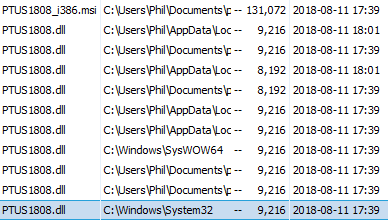
Now you can actually make the keyboard layouts come alive.
[6] Click the Windows ‘Start’ button (under small red arrow, bottom
left, below)
and start typing ‘Region & language‘. That should bring up this
menu (below) on the
left of the screen. Select the region highlighted in blue as indicated by large
red arrow.

![]() N.B. It has sometimes taken up to 5 mins for the 'Region & languages' screen to
show anything at all. I don’t know why.
If you have to wait that long, just be patient. Do something else and return to 'Region & languages'
a bit later. Else. so much the better...
N.B. It has sometimes taken up to 5 mins for the 'Region & languages' screen to
show anything at all. I don’t know why.
If you have to wait that long, just be patient. Do something else and return to 'Region & languages'
a bit later. Else. so much the better...
Selecting ‘Regions & language’ should produce something resembling
this:
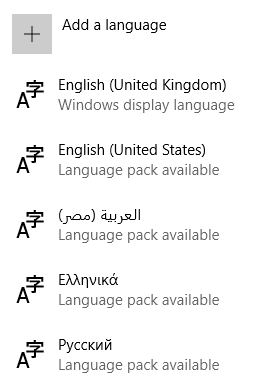
![]() The multilingual keyboard layout is associated
with the Windows English (United States) language
pack.
If English (United States) does not appear in the
‘Languages’ display shown above, you‘ll have to add it first
(press ‘+’ to Add a language).
The multilingual keyboard layout is associated
with the Windows English (United States) language
pack.
If English (United States) does not appear in the
‘Languages’ display shown above, you‘ll have to add it first
(press ‘+’ to Add a language).
The Greek Polytonic keyboard is associated with the Windows Ελληνικά language pack. If Greek/Ελληνικά does not appear in the Windows Languages display, you’ll need to add it first.
The Phonetic Russian keyboard is associated with the Windows Русский language pack. If Russian/Русский does not appear in the Windows Languages display, you’ll need to add it first.
[7a] MULTILINGUAL
Click on English (United States). That should
reveal the following.
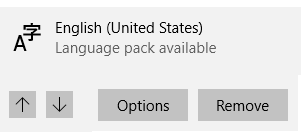
[7b] GREEK POLYTONIC
Click on Ελληνικά. That should reveal:
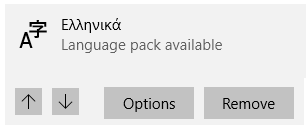
[7c] RUSSIAN PHONETIC
Click on Русский. That should reveal
the following.
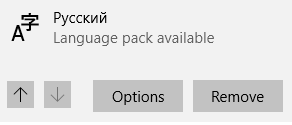
[8] In all three cases (7a, 7b, 7c), select ‘Options' and ensure that your new keyboard layout[s] is/are now available in Windows.
[a] US PT1808 should be under English (United States)
[b] Greek Polytonic should be under Greek/Ελληνικά
[c] Russian Phonetic 1 should be under Russian/Русский
If you don't see anything like that, restart your machine so that the Windows
system
can pick up on what you've just added. Then start again from [6],
above.
If you do see your new keyboard layout[s] as shown under [8], go to [9].
![]() [9] Click on the language abbreviation at the right end of the taskbar, and
then select the keyboard layout you want to use.
[9] Click on the language abbreviation at the right end of the taskbar, and
then select the keyboard layout you want to use.
![]()

If that doesn’t work, use the Windows key + Space bar to cycle through
keyboard layouts you‘ve installed.
![]() Please remember that installation
procedures vary from one (version of an) operating system to another. I’m
assuming readers know how to install a new font on their own devices.
Please remember that installation
procedures vary from one (version of an) operating system to another. I’m
assuming readers know how to install a new font on their own devices.
Language Character Sets
1. Extended multilingual
roman-character keyboard
(2013, update 2019-04 to include μ ♭ ♯ ←
→ ↑ ↓ Ŭ ŭ ♮ ª º)
This keyboard is useful if you need to mention Dvořák, Fauré, El niño, Janáček, Martinů or Schütz; or if you’re quoting Žižek’s review of Rasa Kaušiūtė’s concerts in Łódź, Rīga or Västerås. It’s also useful if you want to settle your account with Dŵr Cymru, or write about something in F♯ minor, or avoid calling Åström Astrom, or writing lecon (obscene) instead of leçon (decent). It also lets you produce some mathematical and financial characters (e.g. × ÷ ∞ ≠ ° ¹ ² ³ ¤ £ € ¥ ). You can even author correctly edited books and articles that use proper quotes (‘…’ or “… ” or «… » instead of "…" or '… '), Em dashes (—, not just - ), bullets (• ▪), section signs (§ ¶) and suchlike.
Extra characters are produced using one of the six dead keys —´ ` ^ ¨ ° ~ — followed by a second key (see Table 1, next). For more about dead keys in the PTkbd layout, click here.
![]() Table 1: key combinations for diacritic letters
Table 1: key combinations for diacritic letters
Examples: to produce ä type dead key ¨ followed by a. To produce ă type dead key ° followed by q. To produce ç type dead key ~ followed by c. To produce é type dead key ´ followed by e. To produce ğ type dead key ° followed by g.

† Ȩȩ is produced by ~ followed by E/e and can be rendered only in fonts with full Unicode support (e.g. Arial Unicode MS)
‡ Ẽẽ is produced by ~ followed by W/w
* Ķķ is produced by ~ followed by K/k
* Ōō is produced by ` followed by K/k
* Ŝŝ is produced by ^ followed by X/x
![]() Table 2: symbol combinations with ´ (1)
Table 2: symbol combinations with ´ (1)
´[ ‘ |
´] ’ |
´{ “ |
´} ” |
´( « |
´) » |
´7 § |
´9 † |
´0 ‡ |
´ SP ´ |
´< ♭ |
´> ♯ |
´! ¡ |
´? ¿ |
´@ ≈ |
´* ± |
´x ≠ |
´p ¶ |
´= = |
´. ´ |
´- — |
´/ ¦ |
´\ | |
´m μ |
´+ × |
´_ ÷ |
´: ▪ |
´; ● |
´8 ∞ |
|
´1 ¹ |
´2 ² |
´3 ³ |
´4 ¼ |
´5 ½ |
´6 ¾ |
![]() Table 3: symbol combinations with ° and ` (2)
Table 3: symbol combinations with ° and ` (2)
° °SP |
| °° |
⅛ °1 |
¼ °2 |
⅜ °3 |
½ °4 |
⅝ °5 |
¾ °6 |
⅞ °7 |
© °c |
® °r |
™ °t |
□ ^0 |
¤ `2 |
£ `3 |
€ `4 |
¢ `c |
¥ `y |
+ ++ |
¨
¨□ |
º °k |
← `< |
→ `> |
↑ `/ |
↓ `\ |
ª °d |
![]() Multilingual layout: dead key info
Multilingual layout: dead key info
This multilingual keyboard layout relies on six dead keys —´ ` ^ ¨ ° ~ — to produce all the extra characters shown above in Tables 1, 2 and 3.
Grave, tilde and circumflex (caret) (` ~ ^) have fixed positions on most anglophone computer keyboards but acute, diaeresis (Umlaut) and ring/degree (´ ¨ ° ) do not.
´ (acute) occupies the position of = (equals), ¨ (Umlaut) has been assigned the + (plus) position, and ° (ring/degrees) has taken over the | (vertical bar) key. Those three occupied key positions (= ¨ |) are instead produced instead by hitting the appropriate key twice in succession, so that == produces =, ++ → +, || → |. The occupying characters (´ ` ^ ¨ ° ~) on their own are generated by hitting the appropriate dead key followed by space, e.g. acute plus space produces acute on its own. i.e. (´SP→´).
Simplified overview of one possible set of multilingual dead key positions on a computer keyboard

Symbols for English, French and Swedish phonemes. The symbols above read: När sjuksköterskan var färdig med son travail she descendait au garage for a quick smoke.
For alternative to installing this keyboard, see option 6a, below.
Cyrillic
keyboard for Westerners — PTrusskbd ![]()
The following Cyrillic letters are more or less where Western Europeans might expect to hear/see them:
Aa Аа | Bb Бб | Dd Дд | Ff Фф | Gg Гг | Hh Хх | Ii Ии | Jj Йй | Kk Кк | Ll Лл | Mm Мм | Nn Нн | Oo Оо | Pp Пп | Rr Рр | Ss Сс | Tt Тт | Uu Уу | Vv Вв | Yy Ыы | Zz Зз
Other Cyrillic characters are produced as follows:
Ee Ее | _- Ээ | + = Ёё | Xx Жж | Cc Чч |Qq Шш | {[ Цц | }] Щщ | Ww Юю | ~` Яя | &* Өө |<, Ьь | °\ Ъъ |
![]() 4. Greek
polytonic / ελληνικό πληκτρολόγιο
4. Greek
polytonic / ελληνικό πληκτρολόγιο
(incl. Ancient Greek diacritics — GkPolytonicKbd)
Includes all Modern Greek characters with accents (αάβγδεέζηήθιίκλμνοόπρσςτυύφχψωώ plus capitals, numerals and symbols). Based on standard Greek keyboard layout with colon and semicolon on Q and accent on ;
To produce "Ξενάκης" type "Jen;akhw" (; is the accent dead key preceding the requisite vowel, e.g. ά = ;a). This keyboard also includes all Ancient Greek letters with accents, breathings and iota subscripts and adscripts. Please note that these characters are only visible in fonts with full Unicode support (e.g. Arial Unicode MS): ἀ ἐ ἠ ἰ ὀ ὐ ὠ ἁ ἑ ἠ ἱ ὁ ὑ ὡ ἄ ἔ ἤ ἴ ὄ ὤ ἅ ἕ ἥ ἵ ὅ ὕ ὥ ᾳ ῃ ῳ ᾄ ᾔ ᾤ ᾇ ᾗ ᾧ ᾱ ῑ ῡ ῒ ῢ, etc., e.g. ᾠδή = {ψδ;η.
5. 中国音乐通
“Ideographs for Idiots”: simple Chinese
character generation for non-Sinophones
Prerequisites
Also useful
Limitations
Example: generating the Chinese character for the English word good.
All ideographs on this page were produced using
the procedures just described. Same goes for the words meaning ‘thank you’
(xiè
xiè, 谢谢) and ‘Philip
Tagg’ (dàofěilĭ, 道斐理,
my Chinese name). That’s the sad extent of my knowledge of Chinese!
You can of course also copy and paste Chinese text from online documents if
you can identify the ideographs you need to use.
谢谢 (道斐理)
人人生而自由,在尊严和权利上一律平等。他们赋有理性和良心,并应以兄弟关系的精神相对待。
All human beings are born free
and equal in dignity and rights.
They are endowed with reason and conscience and should act towards one another
in a spirit of brotherhood.
6. Other keyboard and font solutions
6a Instead of installing a special phonetic keyboard layout, as described under §2↑, you can choose to enter phonetic symbols directly into your document by picking them from this site and pasting them where you want them to appear. Be aware that this method only covers phonetic symbols relevant to the English language.
6b Instead of installing an integral multilingual keyboard layout, as described under §1↑, you can choose to either try and make do with the conventional ‘international’ options offered by Windows or Macintosh, or to generate the missing glyph using a UTF code you can find in an online table somwhere, or to pick the missing glyph from a document containing it.
There are plenty of music fonts available on the internet but very few of those are designed to be incorporated into standard text files. That is exactly what the two fonts XPTMusic.ttf and XPTChords.ttf, presented here, are supposed to do.
XPTMusic.ttf and XPTChords.ttf
![]() 1. XPTmusic.ttf or XPTmusic.otf (music fonts)
1. XPTmusic.ttf or XPTmusic.otf (music fonts)
Both these fonts let you type musical symbols straight into standard text documents without increasing the line spacing. Please note that notation of pitches, as on a stave, cannot be contained in a standard text document and must be entered using musical notation software. Digitally stored notation must then be converted and exported to an image file (see video ‘MuseScore file transfer via image into Word’). Despite this two-stage workaround, many musical symbols —not just ♯ and ♭ — can be usefully and easily included in a standard text document (see also Music Note Symbols).
XPTMusic.ttf (or *.otf) includes the sort of symbols (and more) shown below under ‘Description’, i.e. [1] basic unpitched rhythm notation; [2] accidentals; [3] dyanamics markings; [4] time signatures; [5] scale degree symbols (circumflexed numerals), etc.
Lead-sheet and roman-numeral chord shorthand symbols are contained in a special font set —XPTchords.ttf— presented below.
This font lets you type, with simple keystrokes, the following sort of symbols into word-processed documents.
Explanations
XPTchords.ttf specialises in the sort of symbols shown below, i.e. lead-sheet and roman-numeral chord symbols for tertial and quartal tonality (see Everyday Tonality II, chapters 7-10). For other musical symbols, see XPTmusic, above.
Symbol fonts / keyboards
XPTSymbols1.ttf or XPTSymbols1.otf
Description
Many symbols in this font are icons aimed at making the reference apparatus of learned books and articles about music and modern media into a less burdensome, more efficient exercise. I've written about these issues in Guidelines for producing a Reference Appendix for Studies of Music in the 21st Century.